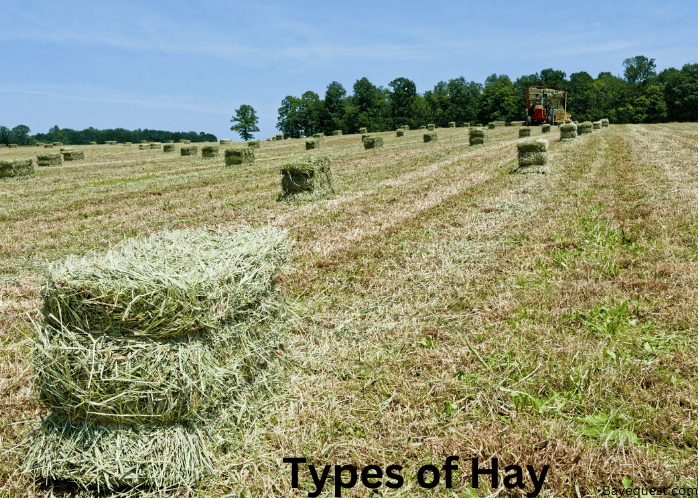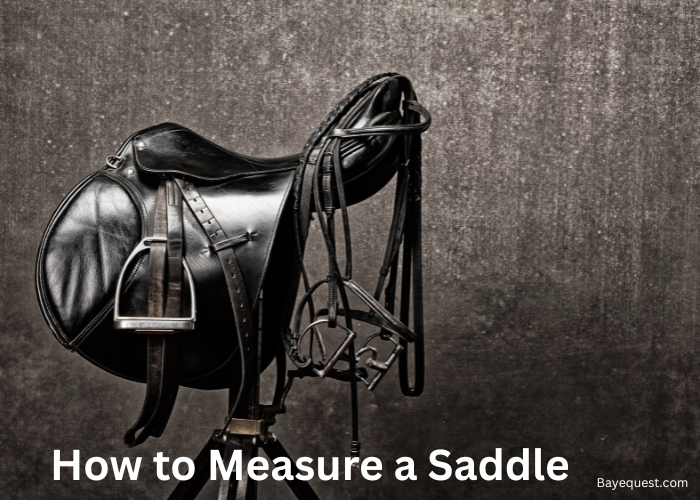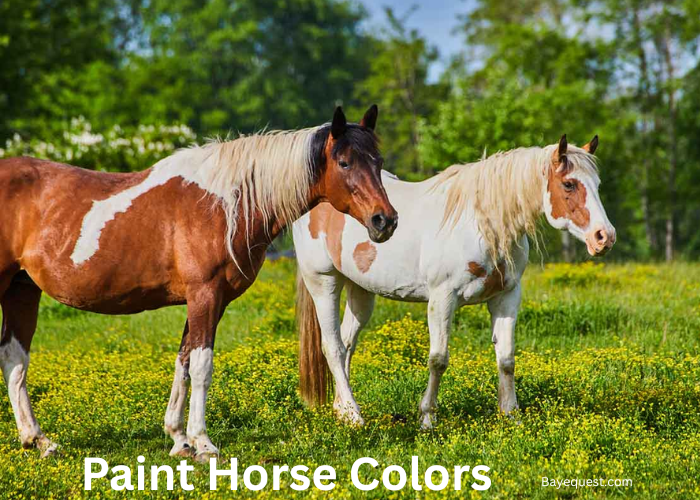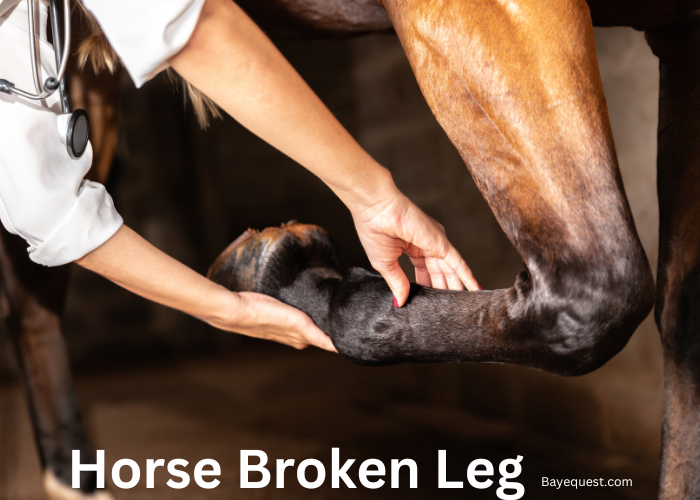Hay is more than just dried grass. It’s a nutrient-packed feast for livestock. Every animal has its preference, from picky horses to easygoing cows.
Some crave sweet, tender hay, while others prefer it tough and chewy.
Alfalfa, Timothy, and Orchard Grass aren’t just fancy names; they’re key players in feeding programs.
Picking the right hay isn’t just about filling stomachs—it’s about keeping your animals healthy and thriving.
Let’s explore the different types of hay and find the perfect match for your herd.
Types of Hay Grasses: Key Takeaway
- Alfalfa hay
- Orchardgrass
- Timothy hay
- Orchardgrass/Alfalfa mix (O/A) hay
- Smooth bromegrass
- Oat hay
- Triticale
- Native Prairie hay
- Bermudagrass hay
- Clover
- Ryegrass hay
- Fescue Hay
- Teff hay
What is Hay Grass?
Hay is dried grass, legumes, or other plants that are cut and cured to be used as animal feed. It’s a staple in the diet of many livestock, including horses.
The purpose of hay is to provide essential nutrients, such as fiber, protein, vitamins, and minerals, that animals need for growth, energy, and overall health.
Good-quality hay is leafy, green, and fragrant, with minimal dust and no mold. It’s more than fodder—it’s a critical part of a balanced diet for many animals.
13 Best Types of Hay for Horses
Discover the top 13 types of hay for horses. Learn what each offers to keep your horse healthy and happy.
1. Alfalfa Hay
Alfalfa hay comes from the alfalfa plant, a legume rich in protein and calcium. It’s like a power-packed energy bar for horses.
This hay is great for young, growing horses, lactating mares, or hard-working performance horses.
But be careful; it’s rich. Too much alfalfa can lead to weight gain or digestive issues like colic. Feed it in moderation, and mix it with grass hay.
Alfalfa is cut, dried, and baled when the plant is at its peak nutritional value. Look for leafy, green bales with few stems. That’s where the good stuff is.
Read also: Is Alfalfa Good for Horses?
2. Orchardgrass Hay
Orchardgrass hay comes from the orchardgrass plant. It has a soft texture and a sweet taste. It’s full of fiber and low in protein, making it a great choice for easy keepers or horses prone to weight gain.
Orchardgrass is gentle on the stomach and works well for horses with metabolic issues. It’s cut early to keep the leaves tender and full of nutrients.
This hay is perfect for mixing with richer hay, like alfalfa, to balance the diet. Horses love its palatability.
3. Timothy Hay
Timothy hay is a popular choice for horse owners. It’s grass hay that’s high in fiber and low in protein and calcium.
It provides good chewing time, which helps with digestion and keeps horses busy. Timothy hay is excellent for adult horses in light to moderate work.
It’s harvested in stages; first cut is stemmy and great for digestion, while later cuts are leafier and richer in nutrients. This hay is all about balance—good for the gut, good for the horse.
4. Orchardgrass/Alfalfa Mix (O/A) Hay
Orchardgrass and Alfalfa Mix, or O/A hay, blends the best of both worlds. You get the fiber and palatability of orchardgrass with the protein punch of alfalfa.
It’s great for horses needing more nutrition but not the full power of pure alfalfa. This mix is ideal for young horses, lactating mares, or performance horses needing balanced energy.
The combination reduces the risk of overloading on one type of nutrient. It’s harvested and baled to keep a good ratio of grass to legume.
5. Smooth Bromegrass Hay
Smooth bromegrass hay is a solid choice for horses needing a steady diet. This grass hay is high in fiber and moderate in protein.
It’s harvested early to keep it leafy and digestible. Bromegrass helps maintain healthy digestion and is excellent for mature horses or those with low energy needs.
It has a soft texture, making it easy to chew and swallow. This hay stores well and stays green and fresh. It’s a dependable option that fits easily into most feeding programs.
6. Oat Hay
Oat hay comes from harvested oat plants. It’s high in fiber but lower in protein and energy than alfalfa.
This makes it a great option for horses that need a filling but not overly rich diet. Oat hay is best fed to horses that don’t require high calories.
It can be stemmy, so check the quality; good oat hay should have plenty of green leaves and a bit of oat grain. Horses find it tasty, and it’s easy on their digestive systems.
7. Triticale Hay
Triticale hay is a hybrid, combining the benefits of wheat and rye. It’s high in fiber and moderate in protein.
This hay is great for horses that need balanced nutrition without too much richness. It’s harvested at the soft dough stage to maximize nutrition.
Triticale is good for mature horses and those with moderate energy needs. It’s also great for mixing with legume hays.
The hybrid nature of triticale brings a unique mix of nutrients that can be very beneficial in a horse’s diet.
8. Native Prairie Hay
Native prairie hay comes from a mix of native grasses. It’s natural, unaltered, and offers a wide range of nutrients.
It’s high in fiber and provides a good variety of vitamins and minerals. It’s perfect for horses that thrive on a varied diet, especially those in light work or at rest.
It’s cut, dried, and baled just like any other hay, but it retains wild, natural flavor horses enjoy.
9. Bermudagrass Hay
Bermudagrass hay is a warm-season grass hay. It’s high in fiber and low in protein, making it suitable for horses needing low-calorie diets.
This hay works well for horses that are easy keepers or prone to gaining weight. It’s harvested in warm climates and baled when the grass is at peak growth.
Bermudagrass is dense and provides good chew time, which is great for digestion. It’s also very affordable and widely available.
Related read: Is Bermuda Grass Good for Horses?
10. Clover Hay
Clover hay comes from clover plants, a legume with a rich, leafy texture. It’s high in protein and moisture content, often mixed with other grass hays.
Clover hay is great for horses needing a boost in nutrition. However, it can mold easily, so it must be stored well.
It’s harvested before it gets too mature to retain its tender leaves. When mixed right, clover adds a nice variety to a horse’s diet.
11. Ryegrass Hay
Ryegrass hay comes from ryegrass, a versatile grass with high digestibility. It’s low in sugar and great for horses with metabolic issues or those needing to watch their weight.
Ryegrass is soft and has fine stems and a rich green color. It’s harvested when it’s leafy and nutritious, not too stemmy.
This hay is often part of a mixed feeding program to provide balance. Ryegrass hay is an excellent choice for those needing to manage weight or metabolic concerns.
12. Fescue Hay
Fescue hay is another hardy grass hay. It’s high in fiber and low in sugar and protein.
It is best for mature horses, especially those not in heavy work. Fescue is cut and baled when it’s still green to retain its nutrition.
But there’s a catch—it can have a fungus that affects pregnant mares, so avoid it for them. Otherwise, it’s a good, steady hay that’s easy on the wallet.
13. Teff Hay
Teff hay is a warm-season grass hay with a soft texture. It’s low in non-structural carbohydrates (NSC), making it a top choice for horses with metabolic issues.
Teff is moderate in protein and high in fiber. It is also ideal for maintaining weight without adding extra energy.
This hay is often used for horses needing careful diet management. It’s nutritious, easy to digest, and helps with weight control.
Factors to Consider When Choosing Hay
Choosing the right hay depends on several factors. These are some of the factors:
1. Nutritional content
Different hay types offer different nutrients. Some are rich in protein and calcium, like alfalfa.
Others, like Timothy or orchardgrass, are high in fiber and lower in protein. The nutritional content affects a horse’s energy levels, weight, and overall health.
Always match the hay’s nutritional profile to the horse’s needs. Too much protein can lead to issues, while too little may not support growth or energy.
2. Stage of maturity when harvested
Hay’s quality depends on when it’s cut. Early-cut hay is leafy, tender, and high in nutrients.
Late-cut hay is stemmy, coarse, and has lower nutritional value. Younger hay is better for horses needing more energy and nutrition.
Mature hay works for those needing less, like easy keepers. The stage of maturity affects digestibility and palatability.
3. Leafiness, color, and smell
Good hay is leafy, bright green, and smells fresh. Leafy hay is richer in nutrients and more palatable.
Brown or yellow hay might be old or poorly stored. Dusty or musty-smelling hay could mean mold or poor quality.
Always choose hay that looks and smells clean and fresh. It should feel soft to the touch, not too coarse.
4. Breed, body type, and energy needs of the animal being fed
Different horses have different needs. A draft horse has different energy requirements than a pony.
Performance horses need high-energy hay, like alfalfa or a mix. Easy keepers or overweight horses do better with low-calorie grass hays.
Consider the breed, size, and workload of the horse. Match the hay type to maintain a healthy weight and energy balance.
5. Types of animals being fed
Not all hay is suited for every animal. Horses, cows, goats, and rabbits all have different needs.
For horses, the focus is on digestibility and energy. High-fiber, low-sugar hay works for many.
Some hays that are great for cows might be too rich or too stemmy for horses. Always choose hay specifically suited for the type of animal you’re feeding.
How to Choose Between Grass Hay and Legume Hay
Choosing between grass hay and legume hay depends on what your horse needs.
Grass hay, like timothy or orchardgrass, is high in fiber and lower in protein and energy. It’s great for easy keepers, horses at rest, or those with low to moderate activity. It keeps them full without adding extra calories.
Legume hay, like alfalfa or clover, is richer. It’s packed with protein, calcium, and energy. This hay suits young, growing horses, lactating mares, or hard-working horses needing more fuel.
Grass hay is a steady meal and legume hay is a power snack.
Which Hay Should You Not Feed Your Horse?
Not all hay is safe for horses. Moldy hay is the top one to avoid—it can cause colic, respiratory issues, or even poisoning.
Dusty hay, that smells musty, or looks brownish isn’t good either. Fescue hay can be risky, especially for pregnant mares, as it may contain a toxic fungus that affects pregnancy.
Sorghum or Sudan grass hay should also be avoided. It can be toxic and cause urinary issues.
Hay with high sugar content, like late-cut ryegrass, can be bad for horses with metabolic problems.
Why You Should Always Check Your Horse Hay
Always check your horse hay before feeding. Even good-looking hay can hide problems.
Mold, dust, or even tiny weeds can cause big issues like colic or breathing trouble. Hay that’s too stemmy or too fine can upset a horse’s stomach.
Sometimes, hay can get wet or spoil in storage, turning bad without you knowing. And remember, some hays might have toxic plants mixed in.
A quick check can save you a vet bill. Look, feel, and smell your hay. Make sure it’s clean, fresh, and safe.
How to Store Hay Properly
Storing hay right is key to keeping it fresh and safe.
First, keep it dry. Moisture causes mold, and mold can harm your horse.
Store hay off the ground on pallets or wooden planks. This keeps air moving and prevents dampness from creeping in.
Stack hay bales with some space between them. It helps with airflow and keeps bales from getting too hot. Hot hay can start a fire.
Cover your hay, but don’t seal it too tight. A tarp works well but leave room for air.
Keep hay out of direct sunlight. Sun bleaches the color and weakens nutrients. Check hay often and make sure it’s still fresh and dry.
Good storage means good hay, and good hay means a happy horse.
How Much Hay Should a Horse Eat in a Day?
A horse needs to eat about 1.5% to 2.5% of its body weight in hay every day. For a typical 1,000-pound horse, that’s around 15 to 25 pounds of hay.
The exact amount depends on the horse’s size, age, and activity level. A hardworking horse needs more fuel, while an easy keeper might need less.
Spread the hay out over several meals. Horses are grazers; they do best eating small amounts throughout the day.
Read also: How Many Bales of Hay Can You Produce?
Types of Hay Grasses: FAQs
How much does a bale of hay weigh?
The weight of a bale of hay varies by type and size. Small square bales weigh between 40 to 60 pounds. Larger square bales can range from 800 to 1,500 pounds. Round bales, often seen in fields, weigh anywhere from 500 to 2,000 pounds.
Haylage vs hay
Haylage and hay both come from grasses and legumes. However, they are processed differently. Hay is cut, dried, and baled with low moisture. It’s great for long-term storage. Haylage is cut and then fermented with higher moisture content, and stored in airtight bags or wraps. It retains more nutrients but needs careful handling to prevent spoilage.
How much is a hay bale?
The price of a hay bale depends on size, type, and location. Small square bales can cost anywhere from $3 to $15 each. Larger square bales and round bales range from $40 to over $100 per bale.
Hay Grass Types: Conclusion
Choosing the right hay for your horse is all about balance. From alfalfa’s high protein to Timothy’s steady fiber, each type offers something unique.
Think about your horse’s needs—age, work level, and health. Mixing different hays can give a more balanced diet and keep things interesting for your horse.
Always check for quality—look, feel, and smell. Good hay means good health, fewer vet bills, and a happy horse.
So, take your time and pick the best hay that suits your horse’s needs. Your horse will thank you.








